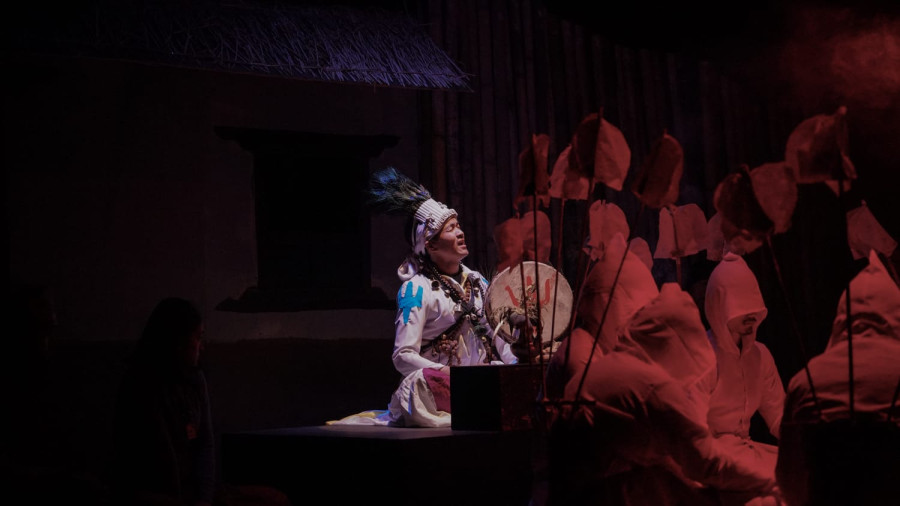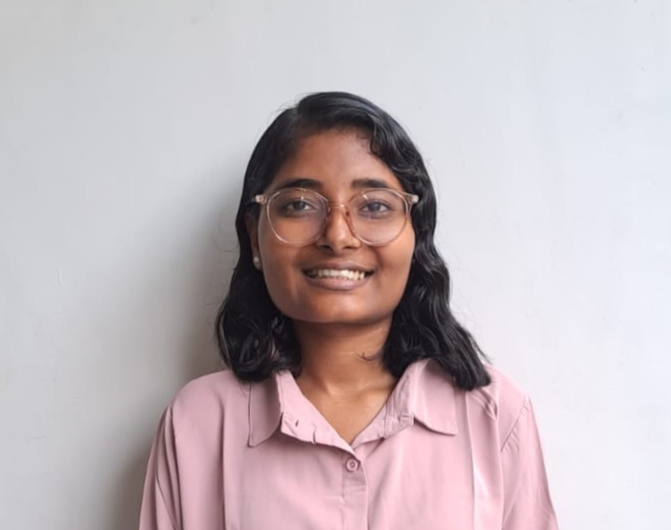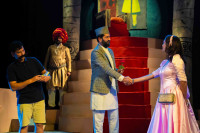Culture & Lifestyle
The battle for identity
Through compelling narratives and symbolic elements, ‘Maasinya’ portrays the harsh realities faced by marginalised communities and their ongoing fight for identity, culture and existence.
Aarati Ray
The struggle for identity and existence has been a constant throughout human history. While we often hear people saying ‘Nepal is a beautiful garden of diversity’, the harsh reality is that issues of many ethnic groups remain overlooked. They are facing injustice within this supposed garden. One such ethnic community is the Tamang community, whose plight is portrayed in the play ‘Maasinya’, written by Laxmi Rumba, Raju Syangtan, and Rabat, and conceptualised and directed by Buddhi Tamang and Sonam Lama.
The title of the play ‘Maasinya’ itself is symbolic. The subjugation of the Tamang community started with the classification of Tamang as ‘masinya matwali’ under the Muluki Ain 1854 by Prime Minister Junga Bahadur Rana. The title ‘Maasinya’, which also signifies something that “can be destroyed, subjugated and oppressed”, foreshadows the struggles and challenges of the Tamang community who have been fighting with the rulers and state authorities of Nepal against exploitation and oppression.
The play depicts the struggles faced by the Tamang community, providing a glimpse into their lifestyle, culture, rhythm and surroundings. Although it presents a narrative about the Tamang community, it resonates with many communities that have been ostracised and dehumanised because of power play and a prejudiced legal system.
‘Maasinya’ begins by immersing us in the world of dhami, jhakris and practitioners of such traditional rituals. We see nine individuals in white clothes and hoods form a circle. Their leader, the bonbo (a ritual specialist in Tamang community, akin to jhakri), stands a little away, playing a dhyangro and chanting mantras to help a girl, Palmo, in mental distress. Bonbo, played by Sonam Lama, asks Palmo questions and she begins to respond.
The storyline then shifts to the past, and we are introduced to Chyangba (Rupesh Lama), who is busy constructing a chorten (a stupa-like structure), in an open space to honour his late parents.
A conflict arises when Chyangba learns that the chorten he built is slated for destruction by the local government due to a road construction project. It intensifies when Chyangba is arrested and tortured for eating beef.
The theatrical execution of the play is impressive, filled with symbols, metaphors and allusions. The exposition instantly catches the audience's attention with its intriguing setting. Most importantly, the director’s vision of including Tamang music right from the start is fitting and instantly hooks the audience.
In the opening scene, we learn that a girl possessed by a ghost is always searching for Chyangba. As the jhakri attempts to summon the ghost within the girl, he delicately scatters red petals upon her, creating a beautiful yet ominous contrast symbolising the connection between beauty and danger, and life and death.
The use of lighting transitions between scenes is clever. For example, as the jhakri summons the soul within the girl, the intensity of the red light gradually increases, turning into a deep red when the ghost is under the control of the jhakri. The controlled ghost expresses grievance, mentioning her search for Chyangba. The scene then shifts abruptly from the present setting to the past as the ghost recalls her history.
The scene where we are introduced to Chyangba building the chorten is crucial as it presents the first conflict in the play. Kaarsaang (Sachin Ratna) and Sangmo (Rohani Lama) all asking and teasing Chyangba about spending all his time near the chorten shows that he has been spending a lot of time working on chorten. The playful and lovely banter between Chyangba and Sangmo provides a breather from the intense scenes of jhakri for the audience, it follows.
Chorten is a symbol of Tamang culture and ancestry in the play. Chyangba’s determination to build it shows how the Tamang community values their culture and ancestry. The chorten being in danger of destruction due to a road construction project shows how, in the pursuit of modernity and development, our heritage and culture is often jeopardised.
The acting in the play is pretty great, with impeccable expressions and a perfect Tamang accent, even when speaking Nepali. Particularly noteworthy are the performances of elderly characters—Aasyang (Chyangba’s maternal uncle) and buddhi aama (Sangmo’s mother), portrayed by Bishnu Moktan and Sanumaya Tamang, respectively. Aasyang’s continuous care for Chyangba and his concerns about Chyangba’s marriage, show his deep love for his nephew. This makes the audience empathise with Aasyang’s distress when Chyangba is arrested.
Aama’s damphu is another motif of Tamang culture. When Chyangba’s relatives and villagers gather at Sangmo’s house to celebrate Makar Sankranti, we see Aama singing and playing danphu, remembering her dead husband. Damphu is used as a relic of love, remembrance and culture, here.
The play subtly foreshadows Chyangba’s arrest, as multiple times during the celebration, people ask, “Khai ta Chyangba? (Where is Chyangba?)”
The scene changes abruptly as Chyangba is beaten by police in the succeeding scene. Chyangba is bent down in front of the chorten on the hill, moaning in pain. Concurrently, Sangmo anxiously awaits him at her house.
The director skillfully uses the stage to depict the emotional distance between the two lovers. Chyangba is positioned in the upper part of the stage, resembling a hill, while Sangmo is in the lower part. This spatial distinction adds depth to their separation, dictated by fate and the cruelty of an unjust system.
Yet another skilful use of space can be seen in the scene where Sangmo, Aasyang and all the kins of Chyangba and Sangmo are pleading for help to the Adhyaksha (head of the village). Adhyaksha and his wife, who are on the roof, look down at them, emphasising the unfair power dynamics and hierarchy. The spatial arrangement also illustrates how the Tamangs are ostracised due to the prevailing power hegemony.
When Aama carries her newborn grandchild from the lap of her dead daughter-in-law, killed by police, and starts climbing the hill, the play reaches the falling point before the resolution. Several elderly people are shown climbing the hill alongside her and they pass chorten covered in black cloth. This collective ascent symbolises how, due to oppression and unjust police system and government, Tamangs like Aama had to migrate from their place of origin. Similarly, chorten covered in black cloth signifies the destruction of culture and hopelessness of the Tamang.
The revelation that the ghost in Palmo’s body is Sangmo’s soul is impactful and adds depth to the play’s message.
A ‘dance’ face-off between Sangmo and the police occurs in the scene following this revelation, symbolising her struggles in seeking justice and finding Chyangba. While this does add aesthetic and abstract elements to the play, it feels confusing for the audience. Bringing Sangmo back for the face-off scene feels unsettling.
Similarly, the scene with Aama and the elderly characters climbing the hill and migrating is executed effectively and feels like a perfect resolution. Yet, an additional scene is introduced at the end, showing a man sharpening his khukuri. This feels like a forced addition and ending the play with a migration scene might have been more compelling.
The play utilised live music consistently, and it served as a crucial link between the performance and the audience. ‘Maasinya’ portrays the richness of Tamang culture, expressed through music, language and history, and resonates not just with members of the Tamang community but everyone who has struggled for identity, culture and existence.

Maasinya
Director: Buddhi Tamang, Sonam Lama
Written by: Laxmi Rumba, Raju Syangtan, Rabat
Cast: Rupesh Lama, Rohani Lama, Sanumaya Tamang
Duration: 90 minutes
Shown till Feb 11
Time: 5:00 pm everyday except Mondays, additional show on Saturday at 2:00 pm
Where: Mandala Theatre, Thapagaun, Kathmandu




 8.12°C Kathmandu
8.12°C Kathmandu


.jpg&w=200&height=120)












